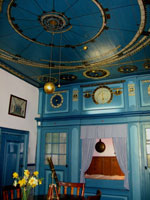WEB FOCUS
Hidden treasures series

In this focus
Every month throughout 2008 Alison Abbott looks into the holdings and history of one of Europe's unique small collections or scientific monuments off the
well-beaten museum track. The series will, we hope, inspire a greater interest in where scientists have come from, and encourage those on the conference
circuit with a few hours to spare to visit these 'hidden treasures'. Delight is guaranteed.
Credit: Combi Hommema/Royal Eise Eisinga Planeterium
Top of page
Articles
Editorials
Secret treasure-troves restored
Reflecting on the endeavours of scientists past can provide both inspiration and pleasure.
Nature 451, 500 (31 January 2008) doi:10.1038/451500a
Editorials
Does the past have a future in Berlin?
Not unless a research institution's managers recognize its value.
Nature 454, 2 (3 July 2008) doi:10.1038/454002a
Books and Arts
Hidden treasures: The University History Museum in Pavia
In the first of a monthly series on small museums, Alison Abbott profiles the University History Museum in Pavia, which recalls the key role of northern Italy in Enlightenment science.
Alison Abbott
Nature 451, 526 (31 January 2008) doi:10.1038/451526a
Books and Arts
Hidden treasures: Eise Eisinga Planetarium
The world's oldest functioning planetarium was built by an eighteenth-century wool-comber in the Netherlands. Alison Abbot reports, in the second of her monthly series on small museums.
Alison Abbott
Nature 451, 1057 (28 February 2008) doi:10.1038/4511057a
Books and Arts
Hidden treasures: Florence's botanical collection
Italy's first centralized museum of plants was one of the early flowerings of the unification movement. Alison Abbott reports on an important scientific legacy.
Alison Abbott
Nature 452, 414 (27 March 2008) doi:10.1038/452414a
Books and Arts
Hidden treasures: Cajal collection in Madrid
The perceptive drawings, paintings, photographs and slides of Spain's neuroanatomy pioneer record a tale of ambition and rivalry, reports Alison Abbott
Nature 452, 940 (24 April 2008) doi:10.1038/452940a
Books and Arts
Hidden treasures: Bologna's Poggi Palace
The exquisite obstetrics models on show in an Italian palace hint at its former multidisciplinary glories. Alison Abbott investigates the museum that was once home to a revolutionary institute of sciences.
Alison Abbott
Nature 453, 597 (29 May 2008) doi:10.1038/453597a
Books and Arts
Hidden treasures: Institute of Physiology collection
A cache of beautiful nineteenth-century German scientific devices that has survived many misfortunes now needs a new home, reports Alison Abbott.
Alison Abbott
Nature 454, 31 (03 July 2008) doi:10.1038/454031a
Books and Arts
Hidden treasures: Padua's anatomy theatre
Alison Abbott finds that human dissections during the Renaissance were rather respectable after all.
Alison Abbott
Nature 454, 699 (07 August 2008) doi:10.1038/454699a
Books and Arts
Hidden treasures: the moulage museum in Zurich
Medical students still learn about skin diseases from hundreds of wax models that also record early cancer research and the ravages of syphilis, reports Alison Abbott.
Alison Abbott
Nature 455, 172 (11 September 2008) doi:10.1038/455172a
Books and Arts
Hidden treasures: Turin's anatomy museum
Some controversial nineteenth-century theories about brain shape and human nature are revealed by an extensive collection of neuroscience memorabilia, reports Alison Abbott.
Alison Abbott
Nature 455, 736 (9 October 2008) doi:10.1038/455736a
Books and Arts
Hidden treasures: The Jagiellonian Museum
Poland's oldest university museum celebrates the Sun-centred ideas of Copernicus and the history of the nation itself, explains Alison Abbott.
Alison Abbott
Nature 456, 577 (4 December 2008) doi:10.1038/456577a
Books and Arts
Hidden treasures: the Paris Observatory
Giovanni Domenico Cassini helped to create an institution that pinpointed Neptune, showed that light had a finite speed � and even mapped France, explains Alison Abbott.
Alison Abbott
Nature 457, 33 (1 January 2009) doi:10.1038/457033a
